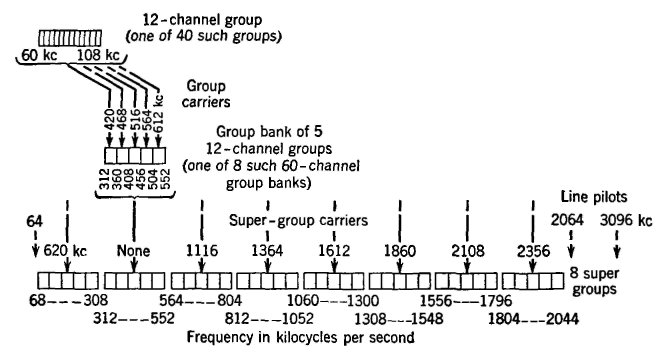| Electrical Communication is a free textbook on the basics of communication technology. See the editorial for more information.... |

|

Home  Telephone Toll Service and Systems Telephone Toll Service and Systems  Type L Coaxial Cable Carrier Telephone Systems Type L Coaxial Cable Carrier Telephone Systems |
|||






|
|||
Type L Coaxial Cable Carrier Telephone SystemsThe United States is spanned with a coaxial cable circuit which was completed about 1948. This circuit can be used for at least two purposes: first, for the transmission of television programs (page 533); and second, for providing a large number of talking channels. Television requires a band of frequencies at least 4,500,000 cycles wide. About 480 telephone talking channels are provided over one coaxial system, and this number has been increased to 600 channels in some instances. Coaxial cables have been used experimentally for television purposes for some years.50 The type L carrier system (and modifications such as the type L1 system) provide telephone channels over coaxial cables. A coaxial cable has no cutoff frequency; however, at high frequencies the loss becomes so great that the repeaters must be placed very close together. There is, therefore, always an upper frequency range above which it is uneconomical to transmit with the equipment and methods available. As previously mentioned, much of the terminal equipment for the types J, K, and L carrier systems is the same. Thus, a complete discussion of the type L system for coaxials is not necessary. The method51 used in arranging 480 telephone conversations for transmission over a coaxial system is as follows: The 480 incoming subscriber telephone lines are separated into groups of 12 and are impressed on carrier equipment such as is discussed in the preceding pages. Each group of 12 channels emerges from the modulators in the frequency band of 60 to 108 kilocycles. Five of these 60- to 108-kilocycle bands (each of which contains 12 conversations) are separated into groups and modulated with "group carriers" so that the 60 telephone conversations they contain lie in the 312- to 552-kilocycle band. Each of these bands (with the exception of one, see Fig. 32) is then modulated with "super-group carriers" and placed in the assigned region in the frequency spectrum. A comparable process is used at the receiving end.
One coaxial tube is used for transmission in one direction, and another tube for transmission in the opposite direction. As many as eight of these tubes are combined into a single sheath, providing four coaxial systems.52 The early coaxial cables used a 13-gauge copper center conductor and a 0.27-inch copper outer conductor. For 480 telephone channels repeaters were necessary at approximately 5.4-mile intervals. A later coaxial cable has an outer diameter of 0.375 inch and repeaters every 7.9 miles. The repeaters use vacuum-tube amplifiers50 specially designed to pass the entire frequency band transmitted.
|
|||
Home  Telephone Toll Service and Systems Telephone Toll Service and Systems  Type L Coaxial Cable Carrier Telephone Systems Type L Coaxial Cable Carrier Telephone Systems |
|||
Last Update: 2011-05-30


